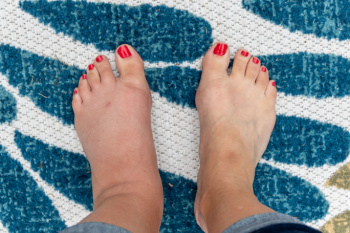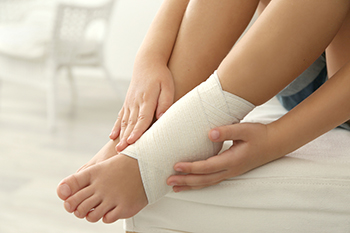Connect With Us
Blog
Items filtered by date: March 2024
When to See a Doctor for Swollen Feet
 Swollen feet can be caused by various things, ranging from simple overuse to more complex health issues. While occasional swelling might not be a cause for immediate concern, especially if swelling goes down with rest and elevation, there are other times when it is important to make an appointment with a foot doctor. If the swelling is persistent, has associated pain, or only affects one foot, it may show underlying problems such as infections, injuries, or vascular disorders that require professional evaluation and treatment. Additionally, if you have pre-existing health conditions like diabetes, heart disease, or kidney problems, swollen feet could indicate complications related to these conditions. Experiencing additional symptoms such as redness, warmth, or changes in skin color around the swollen area also warrants a visit to a foot doctor. Foot doctors, also known as podiatrists, can diagnose the root cause of swollen feet and offer targeted treatment to alleviate the discomfort and any potential health risks. It is suggested that you make an appointment with a podiatrist promptly if you are experiencing persistent swollen feet.
Swollen feet can be caused by various things, ranging from simple overuse to more complex health issues. While occasional swelling might not be a cause for immediate concern, especially if swelling goes down with rest and elevation, there are other times when it is important to make an appointment with a foot doctor. If the swelling is persistent, has associated pain, or only affects one foot, it may show underlying problems such as infections, injuries, or vascular disorders that require professional evaluation and treatment. Additionally, if you have pre-existing health conditions like diabetes, heart disease, or kidney problems, swollen feet could indicate complications related to these conditions. Experiencing additional symptoms such as redness, warmth, or changes in skin color around the swollen area also warrants a visit to a foot doctor. Foot doctors, also known as podiatrists, can diagnose the root cause of swollen feet and offer targeted treatment to alleviate the discomfort and any potential health risks. It is suggested that you make an appointment with a podiatrist promptly if you are experiencing persistent swollen feet.
Swollen feet can be a sign of an underlying condition. If you have any concerns, contact James Torhorst, DPM of Torhorst Foot and Ankle. Our doctor can provide the care you need to keep you pain-free and on your feet.
Swollen feet are a common ailment among pregnant women and people who stand or sit for extended periods. Aging may increase the possibility of swollen feet and patients who are obese often notice when their feet are swelling too. There may be medical reasons why swollen feet occur:
- Phlebitis - A condition that causes the veins to become inflamed and can also cause leg pain.
- Liver disease - This may lead to low blood levels of albumin which is a protein. This can cause fluid in the blood to pass into the tissues and several areas of the body can become swollen.
- Heart failure - When the heart doesn’t pump properly the blood that is normally pumped back to the heart can pool in the veins of the legs causing swollen feet.
- Kidney disease - One of the main functions of the kidneys is releasing excess fluid in the body. This type of condition can make it difficult for the kidneys to function properly, and as a result the feet may become swollen.
- Deep-vein thrombosis (DVT)- This is a serious condition where blood clots form in the veins of the legs. They can block the return of blood from the legs to the heart which may cause the feet to swell. It is important to be treated by a podiatrist if this condition is present.
Swollen feet can also be caused by bone and tendon conditions, including fractures, arthritis, and tendinitis. Additionally, there may be skin and toenail conditions and an infection may cause the feet to swell. Patients who take medicine to treat high blood pressure may be prone to getting swollen feet.
Many patients elevate their feet to help relieve the swelling and this is generally a temporary remedy. When a podiatrist is consulted the reason behind the swelling can be uncovered and subsequently treated.
If you have any questions please feel free to contact our offices located in Waupaca and Stevens Point, WI . We offer the newest diagnostic tools and technology to treat your foot and ankle needs.
Arthritis Can Cause Pain in the Feet and Ankles
Who Is Most Prone to Ingrown Toenails?
 Ingrown toenails, a condition where the nail grows into the skin surrounding it, can affect certain people due to a combination of genetic predispositions, lifestyle choices, and physical activities. People can inherit toenail shapes that are more susceptible to becoming ingrown, such as overly curved or thick nails. These people may also have a familial history of the condition. Additionally, athletes and those engaged in activities that place repeated pressure on the toes, such as soccer, ballet, or running, are at a heightened risk due to the constant stress and trauma to the toenails. Improper footwear that constricts the toes can further exacerbate the likelihood of developing this painful condition. Additionally, improper nail care practices, including cutting toenails too short or with rounded edges, can result in the nail growing into the surrounding skin. Recognizing these risk factors can help you prevent ingrown toenails in the future. If you are suffering from an ingrown toenail, it is suggested you visit a podiatrist. This type of doctor can effectively treat ingrown toenails and offer you suggestions for prevention based on any risk factors you may have.
Ingrown toenails, a condition where the nail grows into the skin surrounding it, can affect certain people due to a combination of genetic predispositions, lifestyle choices, and physical activities. People can inherit toenail shapes that are more susceptible to becoming ingrown, such as overly curved or thick nails. These people may also have a familial history of the condition. Additionally, athletes and those engaged in activities that place repeated pressure on the toes, such as soccer, ballet, or running, are at a heightened risk due to the constant stress and trauma to the toenails. Improper footwear that constricts the toes can further exacerbate the likelihood of developing this painful condition. Additionally, improper nail care practices, including cutting toenails too short or with rounded edges, can result in the nail growing into the surrounding skin. Recognizing these risk factors can help you prevent ingrown toenails in the future. If you are suffering from an ingrown toenail, it is suggested you visit a podiatrist. This type of doctor can effectively treat ingrown toenails and offer you suggestions for prevention based on any risk factors you may have.
Ingrown toenails can become painful if they are not treated properly. For more information about ingrown toenails, contact James Torhorst, DPM of Torhorst Foot and Ankle. Our doctor can provide the care you need to keep you pain-free and on your feet.
Ingrown Toenails
Ingrown toenails occur when a toenail grows sideways into the bed of the nail, causing pain, swelling, and possibly infection.
Causes
- Bacterial infections
- Improper nail cutting such as cutting it too short or not straight across
- Trauma to the toe, such as stubbing, which causes the nail to grow back irregularly
- Ill-fitting shoes that bunch the toes too close together
- Genetic predisposition
Prevention
Because ingrown toenails are not something found outside of shoe-wearing cultures, going barefoot as often as possible will decrease the likeliness of developing ingrown toenails. Wearing proper fitting shoes and using proper cutting techniques will also help decrease your risk of developing ingrown toenails.
Treatment
Ingrown toenails are a very treatable foot condition. In minor cases, soaking the affected area in salt or antibacterial soaps will not only help with the ingrown nail itself, but also help prevent any infections from occurring. In more severe cases, surgery is an option. In either case, speaking to your podiatrist about this condition will help you get a better understanding of specific treatment options that are right for you.
If you have any questions please feel free to contact our offices located in Waupaca and Stevens Point, WI . We offer the newest diagnostic and treatment technologies for all your foot and ankle needs.
Symptoms of an Ankle Sprain
 An ankle sprain is a common yet potentially debilitating injury. A sprain occurs when the ligaments that support the ankle joint are stretched or torn. People with an ankle sprain often report a variety of symptoms that can vary depending on the severity of the injury. At first, the affected area may exhibit swelling and bruising. Pain is a hallmark symptom, and it may intensify when weight is applied to the injured foot. In more severe cases, someone may hear or feel a popping sound at the moment of injury, indicating a possible ligament rupture. The ankle joint may have a reduced range of motion and can feel tender to the touch. These symptoms collectively impair an individual's ability to perform daily activities, making it important to get professional evaluation and treatment. A podiatrist can accurately assess the extent of the damage of an ankle sprain through physical examination and imaging tests. If you suspect an ankle sprain, it is suggested you make an appointment with a podiatrist for diagnosis and an appropriate treatment plan.
An ankle sprain is a common yet potentially debilitating injury. A sprain occurs when the ligaments that support the ankle joint are stretched or torn. People with an ankle sprain often report a variety of symptoms that can vary depending on the severity of the injury. At first, the affected area may exhibit swelling and bruising. Pain is a hallmark symptom, and it may intensify when weight is applied to the injured foot. In more severe cases, someone may hear or feel a popping sound at the moment of injury, indicating a possible ligament rupture. The ankle joint may have a reduced range of motion and can feel tender to the touch. These symptoms collectively impair an individual's ability to perform daily activities, making it important to get professional evaluation and treatment. A podiatrist can accurately assess the extent of the damage of an ankle sprain through physical examination and imaging tests. If you suspect an ankle sprain, it is suggested you make an appointment with a podiatrist for diagnosis and an appropriate treatment plan.
Although ankle sprains are common, they aren’t always minor injuries. If you need your ankle injury looked at, contact James Torhorst, DPM from Torhorst Foot and Ankle. Our doctor can provide the care you need to keep you pain-free and on your feet.
How Does an Ankle Sprain Occur?
Ankle sprains are the result of a tear in the ligaments within the ankle. These injuries may happen when you make a rapid shifting movement while your foot is planted. A less common way to sprain your ankle is when your ankle rolls inward while your foot turns outward.
What Are the Symptoms?
- Pain at the sight of the tear
- Bruising/Swelling
- Ankle area is tender to touch
- In severe cases, may hear/feel something tear
- Skin discoloration
Preventing a Sprain
- Wearing appropriate shoes for the occasion
- Stretching before exercises and sports
- Knowing your limits
Treatment of a Sprain
In many cases, the RICE method (Rest, Ice, Compression, and Elevate) is used to treat ankle sprains. However, you should see a podiatrist to see which treatment option would work best with your injury. In severe cases, surgery may be required.
It is important to ask your doctor about rehab options after you receive treatment for your injury. Stretching, strength training, and balance exercises may help the ankle heal while also preventing further injury.
If you have any questions, please feel free to contact our offices located in Waupaca and Stevens Point, WI . We offer the newest diagnostic and treatment technologies for all your foot care needs.
Common Running Injuries and Prevention Strategies

Engaging in running offers numerous health benefits, but it also comes with the risk of encountering common injuries that can sideline even the most dedicated runners. One common issue is plantar fasciitis, causing heel pain. This condition is often a result of overuse or improper footwear. Regular stretching and wearing supportive shoes can be preventive measures. Achilles tendinitis, involving inflammation of the Achilles tendon, emphasizes the importance of gradual training increments and proper footwear. Prioritizing rest, cross-training, and incorporating strength exercises into one's routine can significantly reduce the risk of these common running injuries, ensuring a more enjoyable and injury-free running experience. If you are experiencing foot, toe, or ankle injuries related to running, it is suggested that you consult a podiatrist who can recommend effective treatment options.
Exercising your feet regularly with the proper foot wear is a great way to prevent injuries. If you have any concerns about your feet, contact James Torhorst, DPM of Torhorst Foot and Ankle. Our doctor will treat your foot and ankle needs.
How to Prevent Running Injuries
Many common running injuries are caused by overuse and overtraining. When the back of the kneecap starts wearing out and starts causing pain in your knee, this is commonly referred to as runner’s knee. Runner’s knee is a decrease in strength in your quadriceps and can occur if you’re not wearing properly fitted or supporting shoes. To prevent runner’s knee, focusing on hip strengthening is a good idea, as well as strengthening your quads to keep the kneecaps aligned.
What Are Some Causes of Running Injuries?
- One cause of a common running injury is called iliotibial band syndrome.
- Plantar fasciitis is also another common injury.
- Stress fractures can occur from overtraining, lack of calcium, or even your running style.
Best Ways to Prevent Running Injuries
- Wear footwear that fits properly and suits your running needs.
- Running shoes are the only protective gear that runners have to safeguard them from injury.
- Make a training schedule. Adding strengthening exercises as well as regular stretching can help keep you strong and limber and can lessen the possibility of injuries.
- Stretching keeps muscles limber; this will help you gain better flexibility.
If you have any questions please feel free to contact our offices located in Waupaca and Stevens Point, WI . We offer the newest diagnostic and treatment technologies for all your foot and ankle needs.

